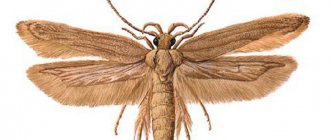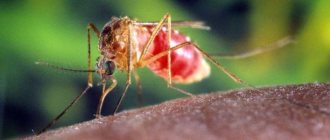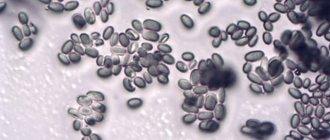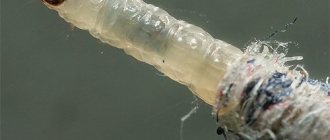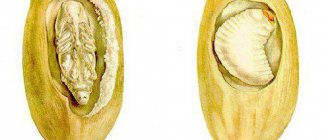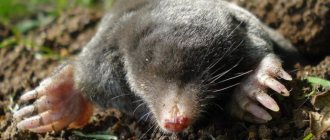The leaf beetle (lat. Chrysomelidae) belongs to one of the most numerous families of Coleoptera. It is distributed throughout the world, except Antarctica and most of the Arctic. The leaf beetle causes serious damage to agricultural crops and its appearance on a personal plot can lead to partial or complete loss of the future harvest.
To prevent this, you need to be able to promptly recognize signs of pest damage to plants and know what control measures should be used.
Description and appearance of the pest
The leaf beetle family has more than 35 thousand species. About 1.5 thousand species of these insects are found in Russia, of which about two hundred are agricultural pests. Damage to plants, shrubs and trees is caused by both adults and larvae.
Due to the variety of species of leaf beetles, these insects may vary in appearance. Their body shape is round-oval, flattened or elongated. The size of insects varies from 3 mm to 1.5 cm. All representatives of this family have upper hard elytra, similar to a shell, and on the body there are outgrowths and modified spines.
In most cases, leaf beetles have a bright, multi-colored color, but representatives of black, gray or brown shades are also found. The peculiarity of all leaf beetles is that they know how to hide their legs and antennae, hiding them under the body. This gives the impression that the insects have no limbs at all.
Leaf beetles have a short head, a keel on the forehead, and tubercles behind it. Also in the front of the body there are periorbital and frontal grooves, which are located above the round eyes. On the insect's head there are whiskers consisting of 11 segments. Their length is usually shorter than half the size of the insect's body. The whiskers are directed up or down; they help the pest navigate in space and easily find a food source.
The wings of the leaf beetle are well developed, longitudinal veins are visible on them, and the edges of the elytra are curved ventrally. The mesothorax of an insect is always smaller than the posterior part of the body. The leaf beetle has three pairs of segmented legs. Males are slimmer and slightly smaller than females.
Types of beetles
There are several types of leaf beetles that are well known to gardeners, gardeners and farmers. They are capable of causing significant damage to crops.
Colorado beetle
Among them:
- Colorado potato beetle (Leptinotarsa decemlineata). The body size is up to 12 mm, and the width is about 6 mm. The color is bright yellow-orange with dark dots on the head and longitudinal stripes on the elytra. Prefers to eat nightshade crops, namely potatoes, tomatoes, eggplants.
- The magnificent leaf beetle (Chrysolina fastuosa). The body of this insect species is shiny. The front part is dominated by a green tint, which turns into copper-red or gold. Also, two blue spots are clearly visible on the head. The diet is based on field and meadow plants, but the insect can also harm agricultural crops.
- Cabbage or horseradish leaf beetle (Phaedon armoraciae). The body of this species of leaf beetle is oval in shape, the color is dark green with a metallic sheen. The insect size is 3-4 mm. Causes serious damage to cabbage plantings, which is why it got its name. But it also feeds on turnips, radishes, radishes, and horseradish.
- Strawberry leaf beetle (Galerucella tenella). This species has a faded light brown color. The pest's body size does not exceed 4 mm. It pesters plantations of wild and garden strawberries and raspberries.
- Green mint leaf beetle (Chrysolina herbacea). A beetle with bright green elytra and a blue-green body. The size of the pest is 8-11 mm. Prefers to eat essential oil crops, and in particular mint.
What are these bugs that eat the plant, what do they look like in the photo?
The sorrel leaf beetle loves to feast on the leaves of young sorrel. It's not difficult to recognize. A shiny bug of a greenish or bluish hue, measuring from 4 to 6 mm. Belongs to the chrysomeline family. In a sexually mature female, the abdomen is greatly inflated. Because of this, she moves rarely and slowly. During this period, the wings only partially cover the abdomen.
The pest overwinters in the depths of the soil. At the end of May, the bugs begin to mate and lay yellowish or orange eggs. Leaf beetle larvae are dirty yellow in color. They intensively eat leaf parenchyma. Only the upper skin of the leaves remains intact. Having had enough of their fill, the larvae pupate in the soil and after a week young beetles can already be observed on the sorrel.
Leaf beetles instantly gnaw holes in sorrel leaves. If measures are not taken to combat parasites, the green harvest will not be large.
In central Russia, two generations of pests appear per season, while in the south there are several. You can also encounter pests in Central Asia, the United States, the Caucasus, Turkey and Korea.
In the following photo you can see what a green beetle looks like.
Life cycle
Leaf beetles have a complete development cycle from egg to adult. With the arrival of May, insects begin their mating season. After fertilization, females lay bright yellow or orange eggs on the undersides of leaves or shoots of food plants. After 2-3 weeks, voracious leaf beetle larvae emerge from them, eating everything in their path.
After 4 weeks, they noticeably increase in size and pupate. Over the next 14 days, their body undergoes a serious metamorphosis. As a result, an imago appears. A day after this, the adult is capable of independently reproducing offspring. The lifespan of leaf beetles is 1-2 years, depending on the species. Throughout the warm season, females breed several generations of offspring.
Both eggs, larvae and adults overwinter.
How to deal with diseases and pests of the bird cherry tree
Below you will find out how you can treat bird cherry trees against pests and diseases in spring, summer and autumn.
False tinder. The causative agent is the fungus Phellinus igniarius (L. et Fr.) Quel. – causes white heart rot of trunks, when the wood turns whitish-yellow and crumbles.
Control measures. Removal of dead trees, uprooting of stumps. The fruiting bodies are cut off, the cuts are disinfected with a 3-5% solution of copper sulfate, and covered with oil paint. Preventive spraying of trunks and young trees in the spring before leaves bloom with copper-containing preparations.
Brown spot. The causative agent is the fungus Cercospora padi Bub. et Silver The spots on the leaves are very small, 0.5-3 mm in diameter, irregular in shape, often merging, falling out, whitish above, brown below. By autumn, small sclerotia form.
Control measures. Collection of fallen leaves. Preventive spraying with copper-containing preparations in the spring.
Bird cherry pockets. The causative agent is the fungus Taphrina pruni Fuck, var. padi Jacz. leads to deformation and ugly growth of the ovaries into brown sac-like formations 1-3 cm long. Inflated hollow fruits have no seeds, over time they become covered with a waxy, dirty-gray coating of sporulation, dry out and fall off.
Control measures. Collection of plant residues, preventive spraying with copper-containing preparations before flowering.
Bird cherry ermine moth Yponomeuta evonymellus L. Silvery-white butterflies with a wingspan of 23-25 mm. The caterpillars are fusiform, yellow-greenish-gray, 20-24 mm long, with grayish hairs on black warts. Younger caterpillars overwinter under the egg shield, from April they damage the buds and eat holes, skeletonize and completely gnaw off young leaves. They live in groups. Butterflies fly from July to August. Females lay up to 40 eggs on the bark under the scutellum.
Control measures. How to deal with these tree pests? To combat bird cherry moths, spraying is carried out in the spring with the following preparations: Fitoverm, Kinmiks, Fufanon, Spark, Inta-Vir.
Bird cherry leaf beetle Phytodecta quinquepunctatus F. A beetle 5.0-6.5 mm long, yellow in color with or without black spots on the elytra. The larvae are flat, green with 3 pairs of thoracic legs. Younger larvae skeletonize young leaves, older and adult beetles gnaw irregularly shaped holes on the leaves. One generation develops.
Control measures. To destroy these pests of trees, if there are a large number of larvae or beetles, the following preparations are carried out: kinmiks, fufanon, spark, Inta-Vir.
Rose leafhopper Typhlocyba rosae L. A small sucking insect, yellowish in color and 3-3.5 mm long. The eggs overwinter on branches; in spring, the larvae feed on the sap of leaves, on which numerous yellowish spots of necrosis appear. The leaves become marbled in color. The larvae feed in May-June and develop into nymphs and adult insects, which also feed on the undersides of the leaves.
Control measures. Spraying with preparations: fitoverm, fufanon, spark, kinmiks, Inta-Vir.
Now that you know how to treat trees against pests and diseases in spring, summer and autumn, do not miss the moment and try to protect your green spaces in a timely manner.
Signs of plant damage
These harmful beetles eat the leaves of various crops, which is why they got their name. Some of the species also eat plant litter and the corpses of other insects.
The adults and larvae of the pests scrape the surface of the leaf blades and make rather large holes in them. Characteristic signs appear in late spring - early summer.
Affected plant
You can also recognize the lesion by the presence of oviposition on the back of the leaves, larvae and, of course, adults, since they lead an open lifestyle. The peculiarity of leaf beetles is that in case of danger they fall to the ground and become motionless, imitating death.
What harm does it cause to plants?
Leaf beetles are divided into pests of trees and cultivated plants and beneficial insects that help control weeds.
Leaf beetle pests attack a great variety of useful plants: strawberries, cabbage, potatoes, eggplants, physalis, peppers, tobacco, tomatoes, beets, cereals, mustard, buckwheat, horseradish, turnips, radishes, asparagus, even garlic and onions.
Other pests spoil the leaf blades of trees: poplar, alder, willow, aspen, birch.
Some species destroy weeds: ragweed, St. John's wort, rapeseed, wild cruciferous plants, nightshade.
The nymph larvae act as cleaners, eating rotten remains of vegetation.
Pest control methods
It is necessary to take measures to combat leaf beetles immediately when signs of damage appear, otherwise after a few days only stems may remain from the plants. It is necessary to use comprehensive measures against pests, which will make it possible to combat leaf beetles at different stages of crop development.
Chemical and biological drugs
Chemical agents help quickly reduce the number of leaf beetles. Preparations based on pyrethroids, neonicotinoids and organophosphorus compounds show high effectiveness. They affect the nervous system of insects, blocking the transmission of impulses from the brain to the limbs. This causes paralysis and then death of the pests. During repeated treatments, the drugs must be alternated to prevent addiction.
The most effective chemicals:
- Chord;
- Decis;
- Karbofos;
- Malaton;
- Confidor;
- Gaucho;
- Monsoon;
- Fatrin.
Biological preparations can also be used to combat leaf beetles. They are based on active compounds that are synthesized by living organisms. Their use is especially important during the period of fruit ripening, as they have a short waiting period. The agents have a contact-intestinal effect.
Popular biological drugs:
- Bitoxibacillin;
- Fitoverm;
- Aktofit;
- Akarin.
Karbofos
Traditional methods
During the flowering period of crops, when the use of chemical and biological drugs is undesirable, folk remedies should be used against the leaf beetle. They are not able to destroy pests, but have a repellent effect.
To protect plants, you need to sprinkle them with dry mustard or wood ash at the rate of 200 g per 1 square meter. m. You can fight leaf beetles by pollinating crops with tobacco dust. Many gardeners recommend installing yellow glue traps in the beds and planting crops with marigolds, garlic, and calendula.
Prevention measures
To prevent the mass reproduction of leaf beetles in your garden or dacha, you need to follow simple preventive measures. They are not able to eliminate the likelihood of pests, but significantly reduce their number in the next season.
Effective measures:
- deep autumn digging of the site followed by spring harrowing;
- burning of plant residues after harvesting;
- regular loosening of the soil and removal of weeds throughout the entire period of crop development;
- pre-sowing watering of the beds with Aktara solution.
How to get rid of parasites?
Leaf beetles pose a real threat to many agricultural crops. To combat them, an integrated approach is used, based on mechanical, biological and chemical destruction of individuals.
At the first detection of individuals on the site, you can try to collect the adults manually. Preventive measures include timely pruning of diseased parts of the plant and their subsequent destruction, burning of fallen autumn leaves and any plant waste, deep digging of the soil after harvesting before frost.
The preparations Actellik and Fosbecid are used for spraying with insecticides, but it is strictly recommended to stop their use 40 days before harvest.
In addition, it is advisable to use folk recipes against insects - spray mint with an infusion of hot pepper or tomato tops. A good effect is obtained by treating plants with infusion of chamomile and dusting the soil with tobacco dust. In addition, it is recommended to promptly get rid of weeds that can attract the mint leaf beetle to the area.


